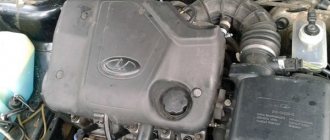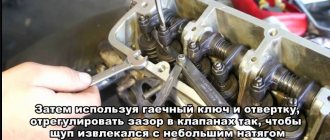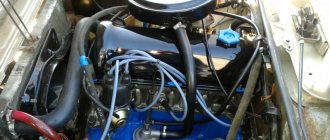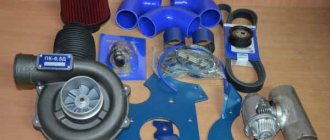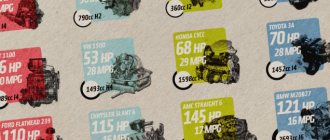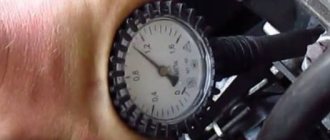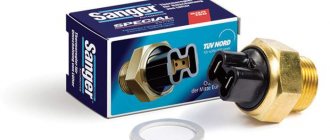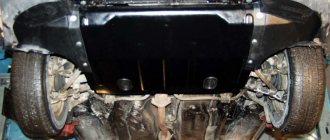The engine is the main power unit of any car, on which both its power and dynamic characteristics depend. VAZ-2107 models are equipped with four-stroke engines, each cylinder of which has two valves. Older cars are equipped with a carburetor engine, and new ones are equipped with an injection engine.
VAZ-2107 engine design
Before we move on to describing the characteristics of the engine, we will talk in detail about all the elements of its design so that you can imagine exactly how the power unit works. Consists of the following main components:
- cylinder block. The heaviest component made from cast iron. This is where the cylinders are located, which are placed in one row. In addition, the block has passages for coolant, which prevents engine overheating during operation;
- the crankshaft, which transmits engine rotation to other components of the car. It also has quite a lot of weight. The crankshaft supports (cranks) are made of metal, which is hardened by high-frequency currents for maximum strength;
- connecting rods with piston pins made of forged steel. These elements are constantly subjected to high loads;
- pistons with compression and oil scraper rings;
- cylinder head. This part is made from a durable but very lightweight aluminum alloy. To prevent lubricant leakage, the cylinder head is equipped with a sealing gasket;
- a flywheel that is used to start an engine. It is in clutch with the starter, which responds to turning the key in the ignition;
- timing mechanism, which includes the camshaft and valve train.
The car engine is a perfect mechanism, in which the lubrication and cooling systems and supply of the air-fuel mixture are well thought out.
Features of operation and maintenance
- Fuel selection
It was said earlier that many drivers cannot decide on the type of fuel used for their engine on the VAZ 2107. And if with AI-92 everything is simple, since its composition is very similar to AI-93, then with AI-95 everything is not so smooth.
Increasing the octane number leads to an increased risk of valve burnout, but gives a small increase in power. The engine begins to run smoother and more stable.
But the designers still took into account the possibility of using AI-95 gasoline. You just need to correctly set the ignition timing on your car (if you have a conventional carburetor engine) or reflash the engine control unit (if your VAZ 2107 engine is fuel-injected). But usually even this is not required. Engines of this brand are very durable and not picky about the type of fuel (within reasonable measures).
- Change of oil
Changing the oil on any engine must be approached with the utmost seriousness. Poor quality oil can lead to not very pleasant consequences, such as accelerated wear of main components and assemblies.
The ability to select oil is a real skill. Taking well-known brands is not always safe, since you are very likely to come across a counterfeit from dishonest companies. At best, you will not receive the positive qualities that this company has. At worst, you will have to carry out major repairs.
You shouldn't buy unknown brands either. In this case, you are buying a pig in a poke. You can buy oil that is of a quality that is not inferior to expensive analogues, or you can end up with expensive repairs. It is best to buy oil in specialized stores, where you can get at least some explanation and compensation.
Another important parameter is the oil class according to the international nomenclature. True, everything is simpler here. You just need to take the oil that the manufacturer himself recommends.
The manufacturer (AvtoVAZ) for VAZ 2107 engines and other models with this type of engine recommends:
- 5W-30;
- 5W-40;
- 10W-40;
- 15W-40.
You need to take about 4 liters of oil. When changing 3.5 liters of oil is usually enough. It’s better to carry the rest with you in the trunk, since oil consumption in this engine leaves much to be desired.
- Changing the oil in the VAZ 2107 engine
The procedure itself is quite simple and should not raise any questions. It is better to change the oil on a VAZ 2107 in the warm season.
- First you need to start the car and warm it up to operating temperature. Then turn it off and let the oil fall back into the crankcase. This will take about half an hour. During this time, we prepare a receiving container with a volume of 4-5 liters, as well as new oil, a watering can and a hose.
- Use a special wrench to unscrew the plug on the crankcase and wait for the old oil to drain out.
- If you change the type of oil or brand, you must also take flushing oil, which will clean the engine of the remnants of the old one. We pour it in the same way.
- Then we tighten the crankcase cover and fill in new oil through the neck on the cylinder head. We measure the level with a dipstick. It should be somewhere between the MIN and MAX marks. Please note that oil is not water and it cannot quickly sink into the crankcase, and therefore after a short stop the oil level in the crankcase will rise a little more.
Usually, along with changing the oil, the oil filter is also changed. It's even simpler here:
- We unscrew the old one using a special tool (you can also use an ordinary rope), lubricate the o-ring of the new filter with oil and screw it in place of the old one.
- Adjustment of valves
Adjusting valves is a rather complicated process and requires certain skills and tools. Actually, it is advisable to entrust the valve adjustment itself to competent specialists, but if you want to do everything yourself, then this video is for you:
Major repairs and maintenance
If valve adjustment can be done at home, then major engine repairs should only be entrusted to specialists.
During a major overhaul, all components and assemblies of the VAZ 2107 engine are checked for serviceability. They will check for you:
- Valve condition, adjustment;
- Chain, chain tension;
- Condition of oil seals, valve stem seals;
- Geometry of the cylinder block;
- Condition of the pistons, crankshaft, pins, connecting rods;
- Wear of compression rings;
- Condition of the oil pump and coolant pump.
If damaged, the part will be replaced. The cylinder block will be bored out, which will increase the combustion chamber and working volume. After this procedure, the car will be run-in for several thousand kilometers.
Typically, running-in lasts 5-10 thousand km. At this time, it is not advisable to give the engine heavy loads. After completing this procedure, your engine will make you happy.
Malfunctions
1. Engine won't start
| Cause of failure | Elimination method |
| No fuel in carburetor | |
| Fuel line clogged | Blow out the fuel line, flush the fuel tank |
| Carburetor and fuel pump filters are clogged | Wash filters and replace if necessary |
| Ignition system is faulty | Check the ignition system, replace broken parts |
| The carburetor air damper does not open at the first flashes in the cylinders | Eliminate leaks in the carburetor starting device |
| The carburetor solenoid valve does not open when the ignition is turned on: | |
| break in the wire going to the valve | Check the wire and its connections, replace the damaged wire |
| solenoid valve faulty | Replace valve |
2. Knock of the crankshaft main bearings.
Usually a dull, metallic knock. It is detected when the throttle valves are opened sharply at idle. Its frequency increases with increasing crankshaft speed. Excessive axial clearance of the crankshaft causes a sharper knock with uneven intervals, especially noticeable with a gradual increase and decrease in the crankshaft speed.
| Cause of malfunction | Elimination method |
| Ignition too early | Adjust the ignition timing |
| Insufficient oil pressure | Check oil pressure |
| Flywheel mounting bolts are loose | Tighten the bolts to the recommended torque |
| Increased clearance between journals and main bearing shells | Sand the journals and replace the bearings |
| Increased clearance between thrust rings and crankshaft | Replace thrust half-rings with new ones or thicker ones |
Engine tuning
The most popular types of tuning for engines of this type are increasing the displacement, replacing the camshaft, installing a zero-resistance filter and direct-flow exhaust.
The most effective way (and the most expensive) is to install a turbo kit.
- Increase in working volume
The design of the VAZ 2103 engine allows for a good increase in displacement, since its cylinder block is almost identical to the VAZ 2106 engine block. And when this block is bored, it can be made to fit the piston and rings of the VAZ 2106 engine.
Thus, we get an increase in displacement, which increases fuel consumption and power. If even this is not enough, then they sharpen the pistons on the valve side and install a crankshaft from the Niva, which also increases the working volume. Presumably after these operations you can get an engine with a displacement of 1.7 liters, sometimes 1.8 liters.
- Installing a new camshaft
This modification does not increase engine power, but changes the nature of its operation. In most cases, they try to install a camshaft that will transfer maximum torque to as low a speed as possible. This makes the engine more responsive at lower speeds, which has a very good effect when driving at low engine speeds. The best option for such a modification is a camshaft from Niva 21213.
- Installation of direct-flow exhaust and zero-resistance filter
The most popular modification. First of all, it's pretty cheap. Secondly, it allows the car owner to show off to neighbors in the garages. In fact, it does not have any practical benefit for the stock engine. Allows you to feel a slight increase in power only at high speeds.
It is quite effective when installing Turbo, since it does not put pressure on the engine, which is now capable of developing enormous power. Direct-flow exhaust is not convenient due to increased exhaust sound. It is dangerous to use the filter in wet weather, as it can let water into the engine, causing water hammer.
- Installation of turbocharging
The most expensive and effective way to increase engine power, while its resource sharply drops by 2-3, sometimes 4-5 times.
Requires deep exhaust tuning:
- Installing T-Valves
- Imported rings and forged pistons
- Lightened crank feces
- Intercooler and much more.
It is also necessary that your VAZ 2107 engine be fuel-injected. The carburetor can simply burst due to such high pressure. This article will not describe the procedure for installing Turbo on a VAZ 2107. There is enough such information on the World Wide Web. Here we will simply indicate a price of approximately 15% of the cost of the car. If you are ready to spend your money on this, go for it.
Characteristics of the VAZ-2107 engine
One of the main characteristics is the engine power of the VAZ-2107, which can vary depending on the modification of the car. For example, since its appearance on the domestic market (1976), three models with carburetor engines have been produced:
- VAZ-2107 1.5: engine capacity 1451 cm 3, power 72 kilowatts;
- VAZ-21072 1.3: volume 1290 cm 3, power 64 kilowatts;
- VAZ-21074 1.6 l. s: engine capacity 1569 cm 3, power 74 kilowatts.
Problems
Cars with such engines under the hood have enough problems with frequent breakdowns. We must not forget that the engine was designed by Soviet engineers, so its vulnerabilities outnumber its positive qualities. The most common engine breakdowns are as follows:
- It often happens that the VAZ 2107 engine fails. This is a common breakdown that is associated with the fact that the batteries fail. Here it is worth paying attention not only to the ignition and its components, but also to look at the fuel pump.
- The power of the VAZ 2107 engine may drop significantly, and this is very noticeable, since the car stops accelerating normally. This is the first sign that the valves need to be adjusted, since there are no hydraulic compensators in the system.
- Often you have to add oil to the VAZ 2107 engine. Here everything looks much sadder, since this is a signal that the engine is gradually coming to an end. It is worth preparing mentally and financially for the fact that you will have to do major repairs.
- The temperature of the VAZ 2107 engine may not reach operating parameters or the car begins to quickly overheat. Everything is simple here - as a rule, the reason for this phenomenon is that the thermostat gets stuck in a large or small circle, respectively.
Modifications of VAZ 2107
The “Sevens” were equipped with carburetor power units of the VAZ 2103, VAZ 2105 and VAZ 2106 models with a four- and five-speed gearbox. Later versions were equipped with engines with distributed (injection) fuel injection, which made the cars more economical.
Let's take a closer look at the modifications of the VAZ 2107 in the order of their release.
| Brand and modification | Years of manufacture | Engine power, l/s | Engine capacity, cm cube |
| VAZ-21072 | 1982 – 2001 | 64 | 1290 |
| VAZ-21073 | 1982 – 2003 | 76 | 1689 |
| VAZ-21074 | 1982 – 2001 | 75 | 1569 |
| VAZ-21074 | 2001 – 2012 | 75 | 1568 |
| VAZ-21075 | 1982 – 2012 | 65 | 1524 |
| VAZ-21075 | 1982 – 2012 | 68 | 1451 |
| VAZ-21079 | 1995 – 2002 | 140 | 1308 |
The first modifications of the “sevens” (21072) were equipped with a 1.3 liter “five” engine. A little later, it was replaced by a 1.6-liter power unit from the VAZ 2106, which was installed on the VAZ 21074. The VAZ 21073 model, which was sent for export, was equipped exclusively with a 1.7-liter injection engine. Especially for Asian countries, the “Seven” was equipped with a 1.45-liter power unit adapted to A-76 gasoline. All other modifications were equipped with one and a half liter “three” engines.
After 2006, the VAZ 2107 began to be equipped exclusively with a 1.6-liter injection power unit that meets European environmental requirements EURO-3.
Maintenance
In order to get trouble-free operation, as well as to guarantee that the engine will work for as long as possible, you need to properly maintain it. Fortunately, this is quite simple to do, since maintenance can be carried out even in the garage. Many people wonder how much oil is in the VAZ 2107 engine, and the answer is quite simple - the block is designed for 3.75 liters, but during replacement you need to fill in 3.5.
The valves on such an engine need to be adjusted every 10 thousand kilometers. But as practice shows, owners of cars with such a power unit under the hood only do this when the car stops moving. The gasoline filter needs to be changed every 15 thousand kilometers. The chain is tensioned every 40 thousand kilometers and must be replaced after 100 thousand kilometers.
General technical characteristics of VAZ 2107 cars
| 2107 | 210720 | 21074 | 2107420 | |
| Body type | Sedan | |||
| Number of places | 5 | 5 | ||
| Number of doors | 4 | 4 | ||
| Body length, m | 4,145 | 4,145 | ||
| Body width, m | 1,62 | 1,62 | ||
| Body height, m | 1,446 | 1,446 | ||
| Wheelbase, m | 2,424 | 2,424 | ||
| Ground clearance, m | 0,164 | 0,164 | ||
| Curb weight, kg | 1060 | 1060 | ||
| Maximum speed, km/h | 150 | 150 | ||
| Acceleration time to 100 km/h, s | 17 | 16 | ||
| Fuel consumption in the urban cycle, l | 9,6 | 9,6 | ||
| Fuel consumption on the highway, l | 6,9 | 6,9 | ||
| Fuel tank volume, l | 42 | 42 | ||
Main characteristics of VAZ 2107 carburetor and injection engines
| Engine capacity, cm cube | Power, hp | Crankshaft rotation speed, rpm | Cylinder diameter, mm | Piston stroke, mm | Compression ratio |
| Carburetor | |||||
| 1,5 | 71,4 | 5600 | 76 | 80 | 8,5 |
| 1,6 | 74,5 | 5400 | 79 | 80 | 8,5 |
| Distributed injection (injector) | |||||
| 1,5 | 68,0 | 5000 | 76 | 80 | 8,5 |
| 1,6 | 73,7 | 5000 | 79 | 80 | 8,5 |
About first generation LADA 2107 engines (1975 - 2005)
The VAZ 2107, popularly called the “Seven,” is a popular and latest rear-wheel drive classic sedan model produced by AvtoVAZ. In essence, this is a modified VAZ 2105, only more comfortable, with engines of greater power and volume. Over time, these models were replaced by Lada Granta cars. We will look at what engines the VAZ 2107 cars were equipped with, their characteristics and main problems.
ENGINE VAZ 2101
The VAZ 2101 engine is the base engine in relation to the classic VAZ family. There is an opinion that this is a Fiat engine, there is some truth in this, since the VAZ 2101 was created on the basis of the FIAT 124 prototype. Unlike this prototype, the VAZ 2101 had an increased center-to-center distance, which made it possible to create variants with different displacements from 1.3 l. up to 1.8 l. The engine is in-line, with 4 cylinders, the camshaft is overhead, the timing drive is on a chain. Owners of models 1970-1974 note the significant reliability of the engines, the reason is most likely in the control of production by Fiat professionals.
The main problem of the engine can be called increased wear of the camshaft. The engine requires periodic valve adjustment. In addition, it is necessary to regularly clean the carburetor. The engine consumes a lot of oil and is prone to overheating. This can happen if the fan fails or the pump breaks. The engine may smoke, the problem may be in the piston rings. Problems with seals and valve bushings are not uncommon. The engine may stall and the problem is most often a faulty ignition system. These are the main, but not all, problems of the engine.
TUNING OPPORTUNITIES
When thinking about tuning the VAZ 2101 engine, you need to understand that the engine has a large number of problems and generally wears out easily, because of this it will not be possible to attach a large number of additions to it. First of all, tuning the VAZ 2101 involves increasing the working volume. To do this, you will have to increase the piston stroke, change the crankshaft and bore the engine. In addition, you can consider the possibility of eliminating roughness and polishing the cylinder head channels. You can install a compressor. There are several ready-made installation kits on the market. However, it must be remembered that with this approach it is very likely that the engine life will be reduced.
ENGINE VAZ 2103
VAZ 2103 is an in-line carburetor-type engine, it has 4 cylinders and an overhead camshaft, and a chain drive. Compared to the VAZ 2101, the VAZ 2103 has a taller block and a crankshaft with an increased piston stroke.
The engine's crankshaft wears out quickly. In addition, it is necessary to timely adjust the timing chain and adjust the valves. In addition, the carburetor must be cleaned regularly. VAZ 2103 engines are prone to overheating, most often due to problems with the pump. The engine may stall due to a burnt-out valve; in this case, the car must be shown to specialists. In general, it would be fair to say that the VAZ 2101 and VAZ 2103 engines repeat each other in terms of problems. At the same time, according to user reviews, the VAZ 2103 engine is more reliable and unpretentious compared to the 2101.
TUNING OPPORTUNITIES
The easiest and most affordable way to increase the power of a VAZ 2103 engine is by boring the cylinders and increasing the piston stroke, as well as installing a suitable crankshaft. Another option is to bore the engine and fine-tune the cylinder head. Finally, you can increase engine power by installing a turbine or compressor, but this is the most expensive method.
ENGINE VAZ 2105
The VAZ 2105 engine is an analogue of the 21011, with slightly less power and a timing belt drive. Due to the use of a belt, the engine makes less noise. In addition, it should be noted that the 2105 engine does not bend the valves. At the same time, it is necessary to periodically adjust the valve clearances.
Without preheating, the engine often stalls, possibly due to oil thickening. Therefore, it is necessary to pre-warm the engine. Often the VAZ 2105 engine jams, to avoid this, it is necessary to change the oil in a timely manner. If knocking noises occur in the engine, it means the valves need to be adjusted. Otherwise, engine power will decrease, valve burnout is possible, the camshaft may become unbalanced, and fuel consumption will increase. In general, the problems of the VAZ 2105 engine are similar to faults 2101 and 21011.
TUNING OPPORTUNITIES
Increasing the power of the VAZ 2105 engine is possible through a bore for an 82mm piston. In addition, the tuning possibilities are similar to those for the VAZ 2101 engine.
ENGINE VAZ 2106
The VAZ 2106 engine is a logical continuation of the ideas embedded in the VAZ 2103 engine. The main difference between the engines is the change in piston diameter. There is a variation of the engine with index 21067, this is an injection-type gear engine. However, it should be noted that the carburetor in this case is more reliable than the injector. The VAZ 2106 engine has 4 cylinders and an overhead camshaft; the timing drive uses a chain.
The VAZ 2106 engine is less reliable compared to the 2103, and requires pre-warming for reliable starting. The following problems are most typical for the engine. The need to use high-quality oil and replace it in a timely manner. The engine is also quite voracious in terms of oil consumption. In addition, the crankshaft wears out quite quickly. If there is a knocking noise in the engine, this indicates that it is time to adjust the valves. In addition to knocking, characteristic metallic sounds may occur; the problem is most likely in the piston pins or connecting rod bearings; the problem itself can be solved in a service center. In general, various suspicious noises and knocks are characteristic of the VAZ2106. Uneven operation of the engine indicates that the carburetor jets are clogged. The engine often overheats, and the cause may be problems with the thermostat or radiator. In addition, the engine is characterized by tripping, vibration, and engine wedge.
TUNING OPPORTUNITIES
The simplest way to increase the power of a VAZ 2106 engine is to bore and increase the piston stroke. In addition, some craftsmen install an engine from a Priora, this is a rather complicated process, but reliable in terms of increasing power. Finally, if funds allow, you can start installing a turbine.
| Engine | VAZ 2101 | VAZ 2103 | VAZ 2105 | VAZ 2106 |
| Years of manufacture | 1970 — 1983 | 1972 - present time | 1979 — 2006 | 1976 - present time |
| Cylinder block material | cast iron | cast iron | cast iron | cast iron |
| Supply system | carburetor | carburetor/injector | carburetor/injector | carburetor/injector |
| Type | in-line | in-line | in-line | in-line |
| Number of cylinders | 4 | 4 | 4 | 4 |
| Valves per cylinder | 2 | 2 | 2 | 2 |
| Piston stroke | 66 mm | 80 mm | 66 mm | 80 mm |
| Cylinder diameter | 76 mm | 76 mm | 79 mm | 79 mm |
| Compression ratio | 8,5 | 8,5 | 8,8 | 8,5 |
| Engine capacity | 1198 cm cube | 1452 cm cube | 1294 cm cube | 1569 cm cube |
| Engine power | 59 hp /5600 rpm | 71 hp /5600 rpm | 64 hp /5600 rpm | 75 hp /5400 rpm |
| Torque | 89 Nm/3400 rpm | 104 Nm/3400 rpm | 94 Nm/3400 rpm | 116 Nm/3000 rpm |
| Fuel | AI92 | AI93 | AI93 | AI92 |
| Fuel consumption | ||||
| city | 9.4 l/100 km | 9.4 l/100 km | 11 l/100 km | 10.3 l/100 km |
| track | 6.9 l/100 km | 6.9 l/100 km | 8 l/100 km | 7.4 l/100 km |
| mixed | 9.2 l/100 km | 8.9 l/100 km | 9.5 l/100 km | 10 l/100 km |
| Oil consumption | 700 gr. per 1000 km | 700 gr. per 1000 km | 700 gr. per 1000 km | 700 gr. per 1000 km |
| Engine weight | 114 kg | 121 kg | 104 kg | 121 kg |
| Overall dimensions of the engine (LxWxH), mm | 540x522x621 | 565x541x665 | — | 565x541x665 |
| What kind of oil to pour into the engine | 5W-30 5W-40 10W-40 15W-40 | 5W-30 5W-40 10W-40 15W-40 | 5W-30 5W-40 10W-40 15W-40 | 5W-30 5W-40 10W-40 15W-40 |
| How much oil is in the engine | 3.75 l | 3.75 l | 3.75 l | 3.75 l |
| When replacing, fill | about 3.5 l | 3.5 l | 3.5 l | 3.5 l |
| Resource | ||||
| according to the plant | 125 thousand km | 125 thousand km | 125 thousand km | 125 thousand km |
| on practice | 200 thousand km | up to 250 thousand km | 200 thousand km | up to 250 thousand km |
| Tuning | ||||
| potential | 200 hp | 200 hp | 200 hp | 200 hp |
| without loss of resource | 70-75 hp | 80 hp | 80 hp | 80 hp |
| The engine was installed | VAZ 2101 VAZ 2102 VAZ 21035 VAZ 21041 VAZ 21051 | VAZ 21023 VAZ 2103 VAZ 21043 VAZ 21053 VAZ 21061 VAZ 2107 | VAZ 2104 VAZ 2105 VAZ 21072 | VAZ 2106 VAZ 2121 Niva VAZ 21074 |
Features of the VAZ 2107 transmission
| 2107 | 210720 | 21074 | 2107420 | |
| Gearbox type | Mechanical, five-speed | |||
| Clutch type | Single disc, hydraulically driven, dry | |||
| Gear ratios: | ||||
| for 1st gear | 3,67 | |||
| for 2nd gear | 2,1 | |||
| for 3rd gear | 1,36 | |||
| for 4th gear | 1 | |||
| for 5th gear | 0,82 | |||
| for the rear | 3,53 | |||
| Drive axle transmission type | 2-shaft, gimbal | |||
Chassis, steering and braking system
The front suspension of the VAZ 2107 has an independent double wishbone design with two shock absorbers and springs, as well as a stabilizer bar. The rear suspension is dependent with a rigid beam, which is connected to the body through one transverse and 4 longitudinal reaction rods. The suspension design is complemented by two hydraulic shock absorbers with coil springs.
wheels - 5Jxl3H2 (permissible offset 25-30 mm);
tires - 175/70R13 (165/70R13).
The steering mechanism of the VAZ 2107 is a globoidal “worm” driven by a double-ridge roller (gear ratio 16.4). Drive – three-link (2 lateral symmetrical rods, middle symmetrical rod, pendulum arm, swing arm, bipod).
The VAZ 2107 brake system has a foot (foot) drive through a vacuum booster. Its design also includes an emergency sensor and a brake fluid pressure regulator in the rear wheel drive. The parking (hand) brake is activated by a cable that engages the rear wheel chocks. The rear wheels are equipped with a drum-type brake mechanism.
The brake mechanism of the front wheels has a classic disc design with automatic clearance adjustment.

